- Latest reviews
- Culture
- Live reviews
- Melbourne live reviews
Caroline Lee’s charming, textured solo performance in June
By Cameron Woodhead, Sonia Nair and Jessica Nicholas
This wrap of shows around Melbourne includes Caroline Lee in Patrick McCarthy’s offbeat monodrama June, 2:22 A Ghost Story at Her Majesty’s Theatre featuring Dan MacPherson and Ruby Rose, the razor-sharp reflexes of Brisbane-based jazz outfit Trichotomy, Paco Pena’s celebratory Flamenco in Concert, and Werribee Park Mansion’s long-running production of the spookfest What Was That?
THEATRE
June ★★★½
Theatre Works, Until August 5
Silence can be eloquent, and anyone who’s had the pleasure of watching Caroline Lee perform onstage over the years will know how expressive she can be without uttering a word. She is a natural choice for Patrick McCarthy’s offbeat monodrama June, in which the titular character finally speaks, having withdrawn into monastic silence for a whole year.
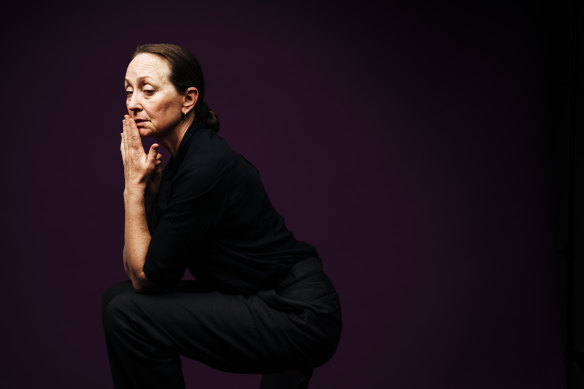
Caroline Lee brings a textured performance to this Theatre Works performance of Patrick McCarthy’s June.Credit: Deryk McAlpin
What prompted June to keep mum for so long? One traumatic cause of her silence is less interesting and less acutely observed – and perhaps more reduced by the attempt to verbalise it – than how June describes the experience of not talking to a soul, or indeed the way she coaxes us into a conspiratorial rapport, as she gives her two cents to a captive audience.
A delicate sense of comedy is key to what becomes an intimate and lightly meta-theatrical reflection on voice and voicelessness, and Lee’s buoyant presence builds a sparkling eccentricity while guiding the character’s reflections on unspoken depths.
June has had time to think, to put into words emotions that are easily ignored. There’s the bittersweet victory of being a mother to well-adjusted adult children with busy lives, the unbearable proximity of a failed relationship, the rage (familiar to women) of being talked over by men, and an agonised reckoning with death and end-of-life care.
The last is least dramatically successful. It’s also the most extended narrative sequence, and it doesn’t feel as psychologically or emotionally authentic as the fugue-like fragments of memory and musing – some of them possessing the arresting quality of poetry – that give the monologue wings in full flight.
McCarthy’s script is more suited to teasing out elusive minutiae of experience than scaling peaks of accumulated feeling. Emily Tomlins’ direction focuses on the work’s strengths, drawing a textured performance from Lee – by turns wry, pensive, steely, and still – that has the auditorium rippling with laughter and holds the stage even when words seem to fail.
Wittgenstein famously said that what we cannot speak about, we must pass over in silence. An actor as good as Lee can hold a silence and make it say anything – and does so ostentatiously, to comic effect, early in this piece. Maybe the play needs to trust in another wordless sequence, as a tragic counterweight, to alleviate the impression that there are a few notes missing in the emotional score.
Still, it’s an intricate solo performance, tackling a complex internal landscape, and some desolating themes, with humour and poignancy.
Reviewed by Cameron Woodhead
THEATRE
2:22 A Ghost Story ★★★
Her Majesty’s Theatre, until 20 August
Horror is so often a vehicle that exposes society’s innermost corners – The Exorcist is largely seen as a metaphor for a young woman’s nascent sexuality, while The Shining is construed as a rejection of America’s imperialism and ill-gotten riches.
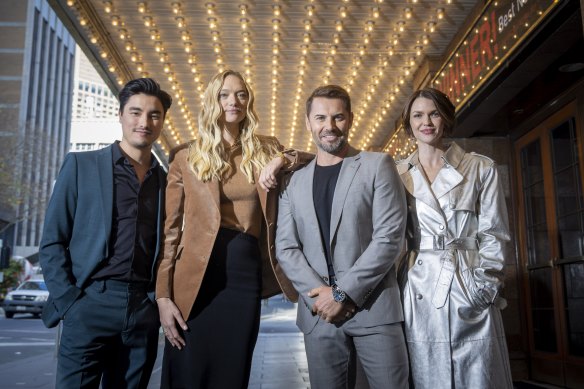
The cast of 2:22 A Ghost Story (from left) Remy Hii, Gemma Ward, Dan MacPherson and Ruby Rose.Credit: Wayne Taylor
Following in this tradition, an examination of spectral ghosts in 2:22 goes on to explore the ghosts of lives never lived, of past lives papered over by gentrification and the changing shape of a city.
Jenny (Gemma Ward) is an exhausted mother whose woes are exacerbated by the sound of phantom footsteps circling her daughter’s cot at precisely 2:22am for the past three nights in their new doer-upper. Wrung out and at her wit’s end, she coaxes her husband Sam (Remy Hii) and their dinner party guests – psychiatrist Lauren (Ruby Rose) and her builder beau Ben (Daniel MacPherson) – to stage a vigil. A menacing red digital clock counts down to the moment of reckoning.
A well-worn divide demarcates the group. Jenny is a believer, and her fears are reified by Ben, whose bullish demeanour belies a latent spirituality. Sam is the Scully to Jenny’s Mulder, his scientific background and pigheaded insistence on his own rationality placing them at an impasse. Lauren, like her field of practice that often invites conjecture on whether it’s art or science, catapults between the two sides.
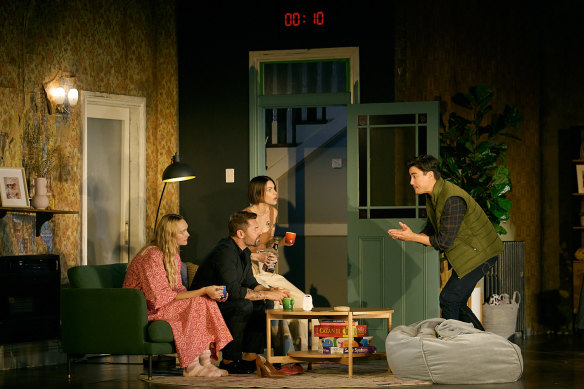
Gemma Ward (left) as Jenny, Dan MacPherson as Ben, Ruby Rose as Lauren, and Remy Hii as Sam share ghost stories as a digital clock counts down to the moment of reckoning.Credit: Eugene Hyland
Under Anna Fleischle’s set direction, the stage is transformed into a haunting picture of domesticity – the peeling wallpaper of the former occupants at odds with the well-appointed kitchen and ceiling rosettes.
But while there are interesting parallels drawn between the incursion of a ghost and the arrival of gentrifiers or faith and reason – Jenny is a lapsed Catholic, while Sam clings to science like it is a religion – the acting, dialogue and poor character development ultimately let 2:22 down.
MacPherson shines as the multilayered Ben, but Hii is one-note as the supercilious, poorly written Sam, while Ward’s overwrought Jenny lacks layers. Lauren’s vacillating between science and belief could have made for an interesting interrogation of selfhood, but in Rose’s hands, the character is rendered confused and incomprehensible.
A blood-curdling scream accompanies every scene transition, initially providing an easy jump scare before becoming tiresome, but more grating are the numerous instances of shrill shrieks attributed to foxes having sex – rather than heighten the tension, they diffuse it. There are Easter eggs as to the eventual twist, which lends the ending dramatic heft, but much remains unanswered.
2:22’s most lingering scares lie in the campfire-style ghost stories shared among characters and in Ben’s monologue about modernisation’s discarding of the old. Here, we get a glimpse of what 2:22 could’ve been.
Reviewed by Sonia Nair
MUSIC
Trichotomy ★★★★½
Ian Potter Centre for Performing Arts, July 29
For a jazz band that’s been together for more than 20 years, Trichotomy has made surprisingly few appearances in Melbourne. Having developed a solid following overseas, this exceptionally gifted Brisbane trio has probably toured Europe more often than they’ve toured Australia.
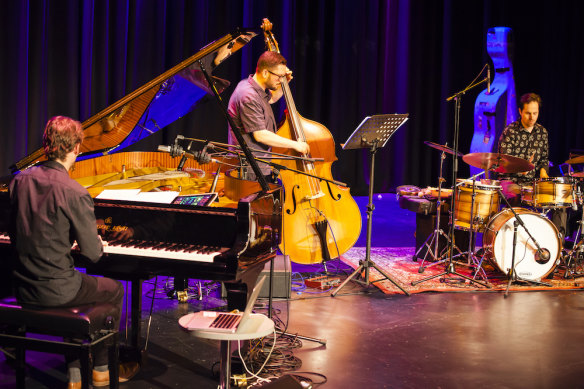
Jazz outfit Trichotomy incorporate electronics into their highly distinctive sound world.Credit: Samantha Covey
So it was a rare treat to catch the band live over the weekend at The Count’s: an elegant jazz club nestled within the Ian Potter Centre for Performing Arts at Monash University. Support act Louisa Rankin opened the concert with a set of delicate originals, Rankin’s wonderfully pure-toned – and mostly wordless – vocals gliding over the lilting themes established by her empathetic trio.
Trichotomy’s visit to Melbourne was prompted by the release of their superb new album To Vanish. Recently, the band has been exploring ways to incorporate electronics into their highly distinctive sound world. On Saturday night, Sean Foran (piano), Samuel Vincent (double bass) and John Parker (drums) utilised various effects to manipulate and expand the sound of their instruments via delay pedals, loops and samples created in real time.
For the most part, these effects were subtly – almost imperceptibly – integrated into the band’s acoustic arrangements: an unearthly piano shimmer here; an additional pulse or bass motif there.
The electronics enhanced the band’s already finely honed ability to shape pieces via constant shifts in tone and dynamics, allowing them to exchange graceful lyricism for sweeping drama in the blink of an eye. Individual solos morphed into collective conversations, as freely improvised passages unfurled within each intricately crafted tune.
The trio’s razor-sharp reflexes were on especially vivid display during their final number: a brilliantly inventive take on Steve Reich’s Clapping Music which transformed a purely percussive piece into an exhilarating synthesis of melodic, harmonic and rhythmic patterns that interlocked to conjure a restless but irresistible groove.
Reviewed by Jessica Nicholas
MUSIC/DANCE
PACO PENA – FLAMENCO IN CONCERT ★★★★½
Melbourne Recital Centre, August 1
More than seven decades after he first picked up a guitar, Paco Pena still radiates a passionate dedication to the art form that has defined his life and career. Perhaps that’s why – after countless tours here and around the world – Pena still sells out concert halls whenever he performs.

Paco Pena’s passion for flamenco remains undimmed.Credit:
Audiences never tire of him because he has never grown tired of flamenco, nor stopped searching for ways to communicate its beauty, drama and complexity.
And it’s not just his passion that remains undimmed. At 81, Pena’s technical facility on the guitar is as astonishing as ever, though he’s completely uninterested in virtuosic displays for their own sake. Opening Tuesday’s concert with a series of solo guitar pieces, he remained half-hidden in shadows as he plucked elegant melodies from rippling, note-filled cascades.
While a single spotlight above him was suitably dramatic, it was a shame his face and guitar were cloaked in darkness, as this was a rare opportunity to focus on the intimate relationship between Pena and his instrument.
Gradually, the rest of the ensemble arrived on stage - another guitarist, two singers, two dancers and a percussionist. Here, Pena became more of an accompanist, leaning forward in his chair to feel and respond to the curl of a dancer’s hand or a singer’s aching cry.
Vocalists Ivan Carpio and Inmaculada Rivero used gestures as extensions of their voices, with arms outstretched or clasped to their heart as they projected anguish and passion with equal vigour.
Each time the dancers (Adriana Bilbao and Gabriel Matias) stepped on stage, all eyes were on them as they transformed the music into visible, shape-shifting energy. They formed a mesmerising pair – at times moving with feline grace as they circled each other or united in a tender embrace; at times striding defiantly, fingers snapping and feet stamping in visceral, staccato bursts.
By the time the company gathered for a celebratory finale, the audience was also on its feet, farewelling Pena and his ensemble as they sang and danced their way off the stage, creating the distinct impression this fiesta would continue long into the night.
Reviewed by Jessica Nicholas
THEATRE
What Was That? ★★★
Essence Theatre, Werribee Park Mansion
Probably the longest-running production in Melbourne, What Was That? is a site-specific promenade performance for small groups. Set in the Werribee Park Mansion, it offers a chance to wander through the grand Italianate building at night, in a ghost tour that combines potted history, low comedy, and light horror.
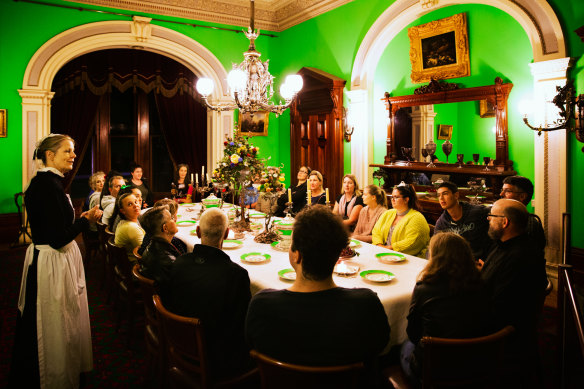
The ghoulish tricks in What Was That? give the long-running production a surprisingly effective fright night appeal.Credit:
The stately home has a haunted past, incorporated into the show. It was built in the 1870s by the Chirnside brothers, Andrew and Thomas, who owned a vast pastoral empire and spared no expense on the property.
But despite their wealth, the Scottish brothers had a dour look about them. Their severe-looking portraits hang above the opulent staircase to the upper level, and Thomas – prone to depression and having been jilted in love – died by suicide after rigging up a shotgun in the home’s laundry. Another grisly death awaited the mistress of the house, and one of the family’s children.
There are more than enough ghosts to support the haunted house trope, and our guides to the spookfest are two servants – a butler (Phil Cameron-Smith) and a head maid (Alaine Beek), soon to be out of a job as the Chirnside family sell the place and move on.

The popular production What Was That? will stage its 1000th performance this month.Credit:
Some of the jokes are unsophisticated. The inebriated butler is a boorish and puerile sort, though the earthy but mischievous Scottish maid is an enjoyable contrast, and the actors throw themselves into their roles, making it easy to be carried along by the fun.
True, What Was That? could have dug deeper into the history of the mansion, but the stories that do get told are atmospheric, inviting us to imagine what it might have been like to live upstairs and downstairs in the imposing house during the Edwardian era.
And ghoulish tricks lend the event a surprisingly effective fright night appeal, with echoing corridors and doors ominously slamming shut, eerie blackouts and objects moving around the room as if by telekinesis, spectral music played from afar and several ghostly apparitions.
The actors throw in deft improvisational comic touches, and some good-natured light participation tailored to the audience.
Given the show has been running for 20 years – What Was That? will celebrate its 1000th performance this month – it is no surprise that this long-running piece of period comedy horror is confident, relaxed, and lively.
Reviewed by Cameron Woodhead
The Booklist is a weekly newsletter for book lovers from books editor Jason Steger. Get it every Friday.